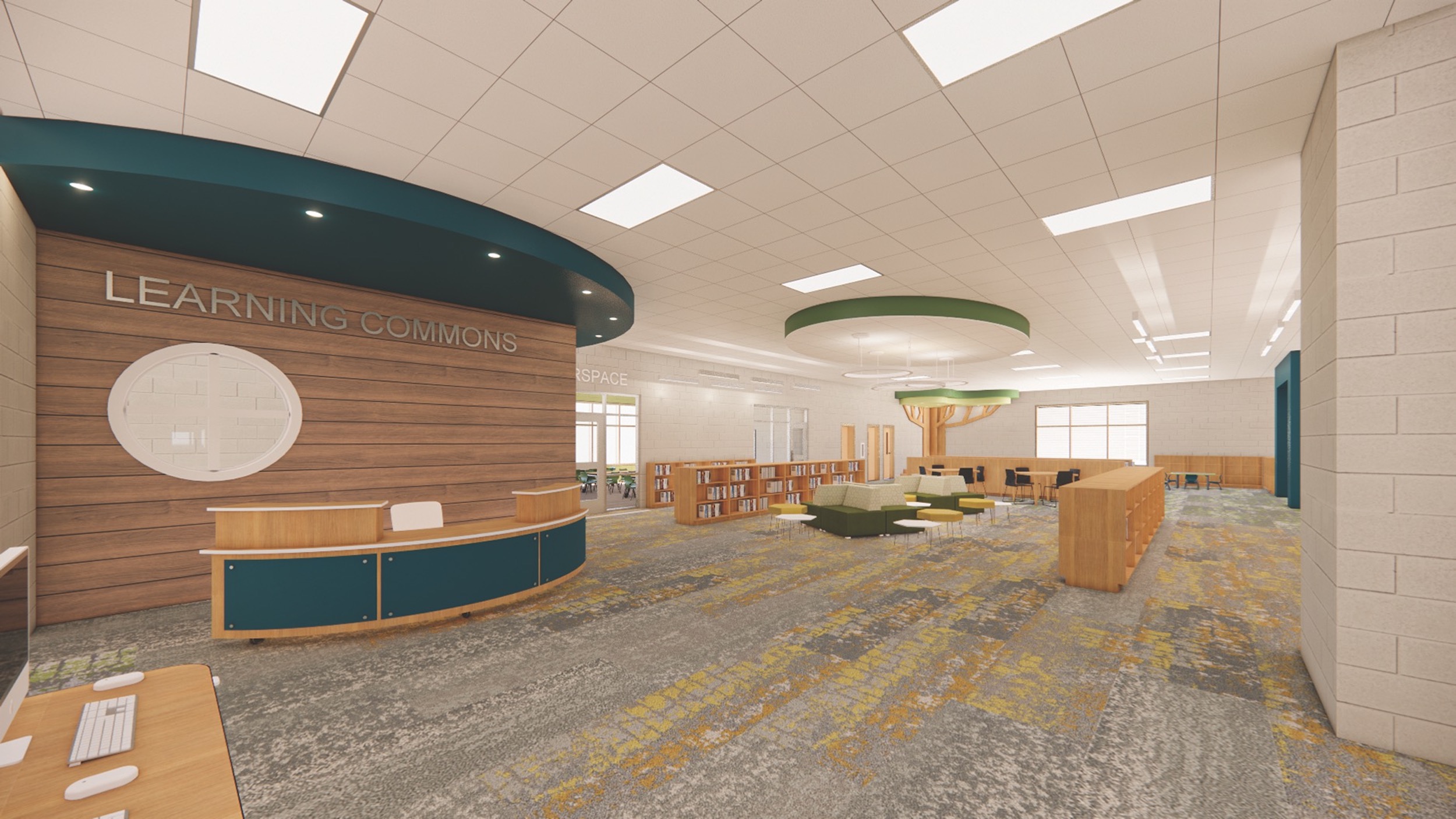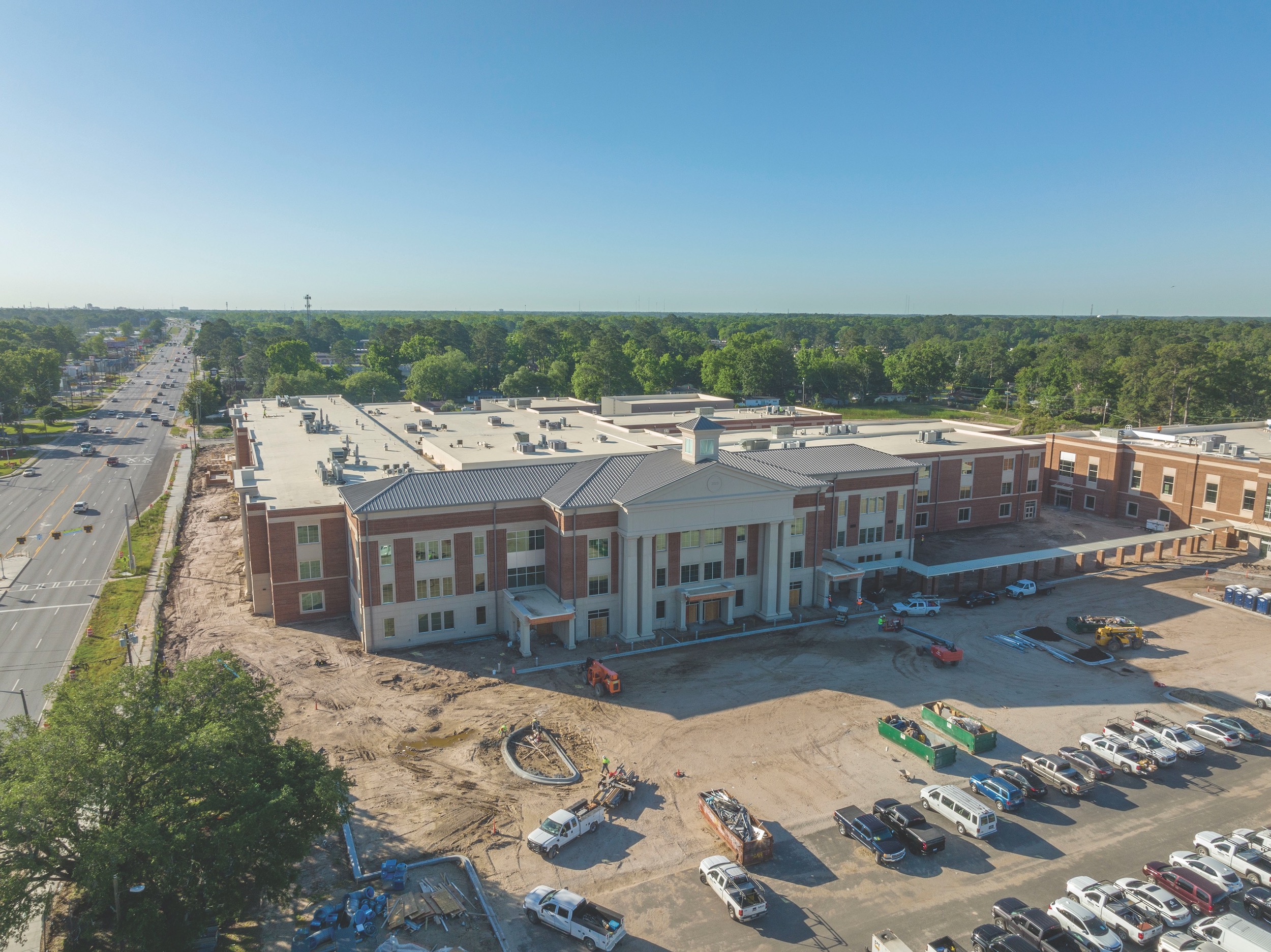In late March, Walsh School District in rural Colorado started construction on a 60,000-sf school that, when completed in the spring of 2024, will teach students in grades Pre-K through 12 under one roof.
In Georgia, the Savannah-Chatham County Public School System (SCCPSS) is wrapping up construction on a 410,000-sf K-12 multi-school project in Garden City, near Savannah, that will enroll about 2,400 students.
While corralling elementary, middle, and high school students in one building isn’t unheard of, it’s still more the exception than the rule, and controversial as news about bullying in schools has become more frequent. “If anything, more schools are separating grade levels,” observes Chris Greer, Henderson Engineers’ K-12 Education Practice Director.
A few years ago, JCJ Architecture designed a one-building K-12 school for a district in Rochester, N.Y. But, says Jim LaPosta, the firm’s Chief Architectural Officer, the prevailing single-building model remains K-8.
However, that could be changing. The general contractor Barton Malow has been working with the Kresge Foundation and the University of Michigan to build PK-16 schools in Detroit. (At least one is under construction, says Mike Stobak, the firm’s Vice President of its K-12 Group.)
The Savannah K-12 school is part of a larger trend toward school building consolidation, in Georgia and other states, asserts David Hamilton, Vice President and Regional Manager for Charles Perry Partners, the general contractor on the Garden City project, whose “all-in” cost is $135 million, according to Dr. Slade Helmly, SCCPSS’s project manager.
Phase 1 of this project, which will be completed this summer, includes two gyms, two cafeterias, and a common kitchen. The school will feature a digital media lab, career and technical education programs for aviation, logistics, and business, a two-story, 750-seat auditorium, and a parking lot with at least 660 spaces. Phase 2 went out for bid in May, says Helmly, and encompasses a fieldhouse and stadium, and campus police department. (The old police station had been on this site, as was Gross High School, both of which were demolished.)
A 50-kW solar array on the new building’s roof will supply one-third of the school’s energy needs.
Addressing security concerns in single-building K-12 schools
Vaughn Dierks, a Partner with Wold Architects & Engineers, which is the Project Architect on the Walsh School District’s PreK-12 school, says that having students of all grades in one building isn’t that big of a deal for this mountain community, where “the kids ride the same bus together, and the older kids look after the younger ones.”
Hamilton thinks that SCCPSS and LS3P Associates—which designed the Garden City school and hired the engineers and contractor for the building team—did a good job separating the lower and upper grades via glass partitions and access-control doors.
April Mundy and Lisa Pinyan, LS3P’s Project Architect and Senior Project Manager/Interior Designer, tell BD+C that their firm designed this campus as three buildings—a primary, middle, and high school—that “share a few common walls.” Administration and student services are strategically located in multiple locations throughout the building, which helps to delineate zones, supervision, and security.


ambitious project as reinforcing the local community. Graphics: LS3P Associates
The idea behind the single-building K-12 school, they explain, is rooted in three basic tenets:
• Improving the educational experience by allowing the administration to adjust classroom grade assignments as enrollment ebbs and flows each year. This environment should also enhance professional development and cross collaboration, and provide more varied learning to students;
• Sharing common core programs and spaces that include specialized arts and performance venues, career education, athletics, and food services; and
• Improving security and operations with centralized systems, so infrastructure can be more efficient by serving a larger student population. Each phase of the building’s design followed Crime Prevention Through Environmental Design (CPTED) principles.
Mundy and Pinyan add that by having the grades together, “we’re able to create a hub and city center for local families to drop off and pick up their children. The goal is for this school to be a catalyst to build a strong community.”
Will single-building K-12 schools become a niche?
This is SCCPSS’s largest project to date, as well as the largest school project undertaken by Charles Perry Partners. “There’s a huge difference between building a $30 million K-8 school and a $100 million K-12 school,” says Hamilton. “It’s a different level of construction.” He’s a big believer in superintendents owning their areas of responsibility, so on this project, his firm brought on board assistant supers with specialties in MEP, exteriors, and so forth. “It was like building a mini company.”
Hamilton says his firm hopes to parlay the Georgia K-12 multi-school building into more multi-school business. “We are definitely showcasing this project, because people want to work with builders that have been there, and have the T-shirt.”
Related Stories
| Jun 9, 2014
Green Building Initiative launches Green Globes for Sustainable Interiors program
The new program focuses exclusively on the sustainable design and construction of interior spaces in nonresidential buildings and can be pursued by both building owners and individual lessees of commercial spaces.
| May 29, 2014
7 cost-effective ways to make U.S. infrastructure more resilient
Moving critical elements to higher ground and designing for longer lifespans are just some of the ways cities and governments can make infrastructure more resilient to natural disasters and climate change, writes Richard Cavallaro, President of Skanska USA Civil.
| May 23, 2014
Top interior design trends: Gensler, HOK, FXFOWLE, Mancini Duffy weigh in
Tech-friendly furniture, “live walls,” sit-stand desks, and circadian lighting are among the emerging trends identified by leading interior designers.
| May 22, 2014
Big Data meets data centers – What the coming DCIM boom means to owners and Building Teams
The demand for sophisticated facility monitoring solutions has spurred a new market segment—data center infrastructure management (DCIM)—that is likely to impact the way data center projects are planned, designed, built, and operated.
| May 20, 2014
Kinetic Architecture: New book explores innovations in active façades
The book, co-authored by Arup's Russell Fortmeyer, illustrates the various ways architects, consultants, and engineers approach energy and comfort by manipulating air, water, and light through the layers of passive and active building envelope systems.
| May 19, 2014
What can architects learn from nature’s 3.8 billion years of experience?
In a new report, HOK and Biomimicry 3.8 partnered to study how lessons from the temperate broadleaf forest biome, which houses many of the world’s largest population centers, can inform the design of the built environment.
| May 15, 2014
'Virtually indestructible': Utah architect applies thin-shell dome concept for safer schools
At $94 a square foot and "virtually indestructible," some school districts in Utah are opting to build concrete dome schools in lieu of traditional structures.
| May 13, 2014
19 industry groups team to promote resilient planning and building materials
The industry associations, with more than 700,000 members generating almost $1 trillion in GDP, have issued a joint statement on resilience, pushing design and building solutions for disaster mitigation.
| May 11, 2014
Final call for entries: 2014 Giants 300 survey
BD+C's 2014 Giants 300 survey forms are due Wednesday, May 21. Survey results will be published in our July 2014 issue. The annual Giants 300 Report ranks the top AEC firms in commercial construction, by revenue.
| Apr 29, 2014
USGBC launches real-time green building data dashboard
The online data visualization resource highlights green building data for each state and Washington, D.C.
















